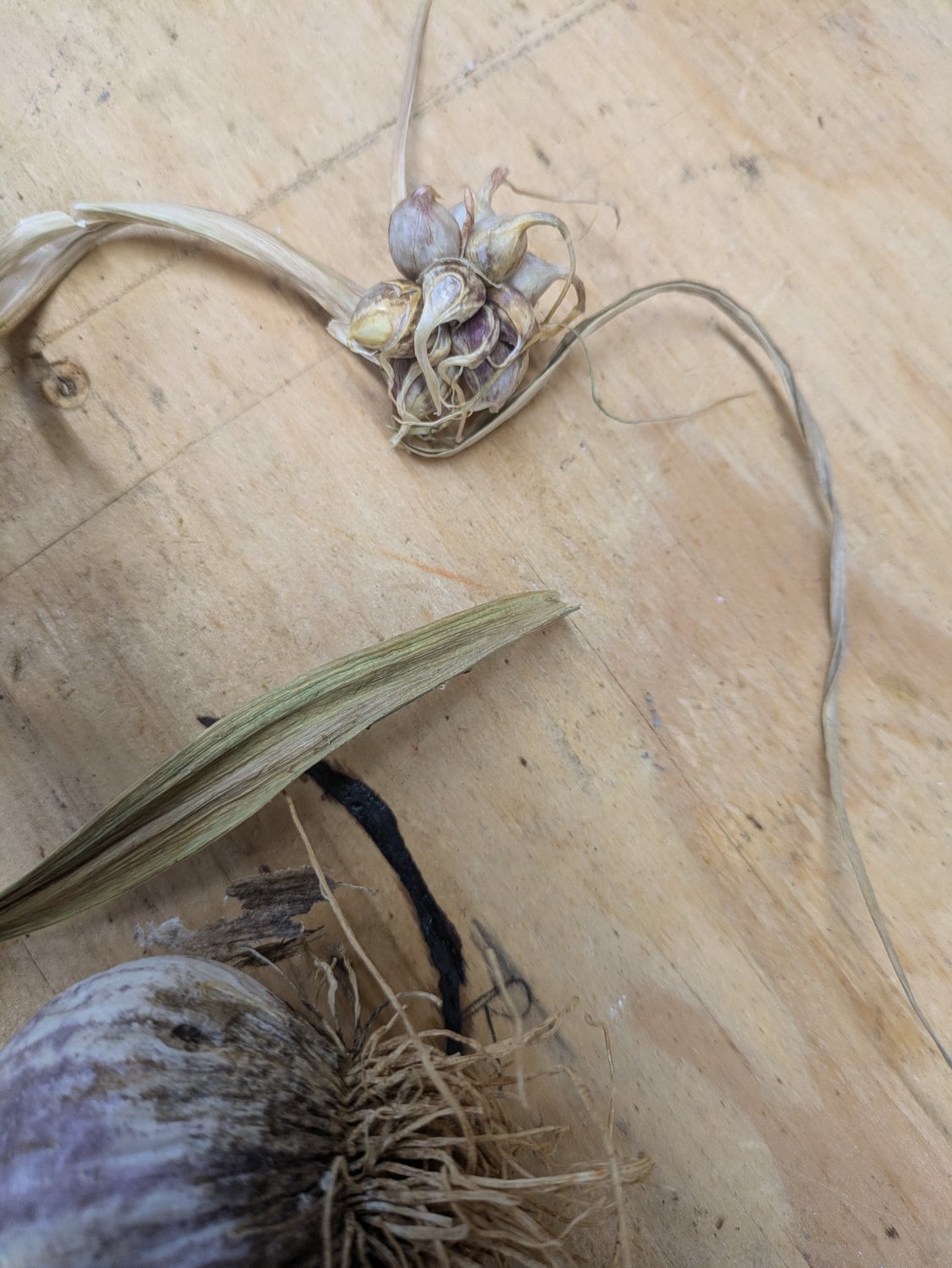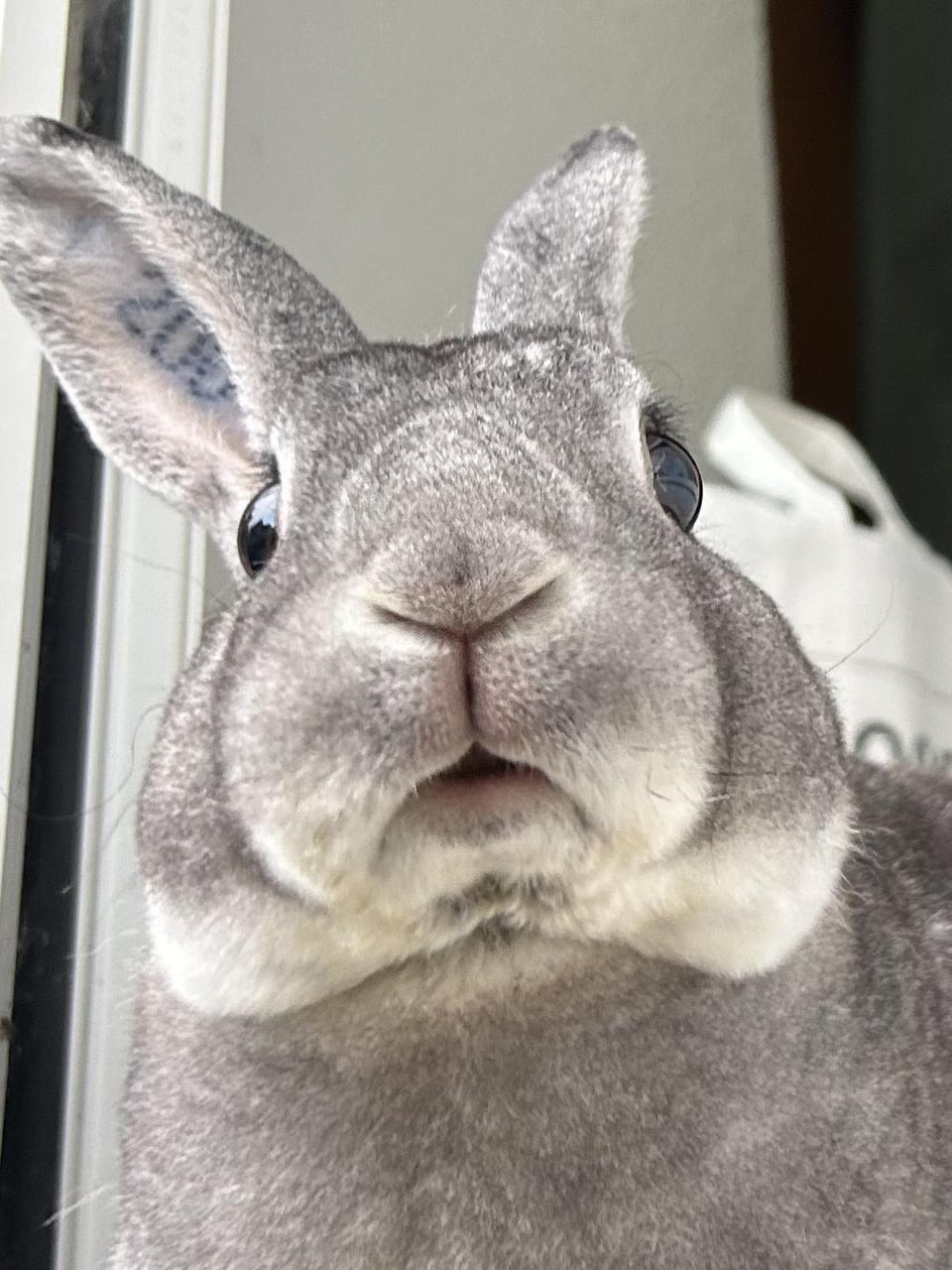[Image description: a perfectly round peeled bulb of garlic on a cutting board, with unpeeled normal cloves behind it.]
Peak mildly interesting content
Wow. My best so far was a bulb with three cloves.
Someone correct me if I’m wrong, but a garlic plant grows some form of a “seed” head, that will have miniature round bulbs in it if they aren’t clipped off that, it’s my understanding, when they are planted they’ll grow like this in the first year and into a normal garlic bulb year two. I’ve never experimented enough to know if I’m correct, but if my info is correct I’d guess either one of those got mixed in by mistake, or if your planting in the same spot as the year prior one might’ve just fallen off.
bulbils
not always, but yes
this is a mutation though, and I’ve seen this kind of “single clove” garlic in the shops
I got one of those this year. I grow hard neck and must have missed the scape on this one.

The bulb and the “seed head”(?) in the pic are the same plant, just bent in half so both are visible
Missed the whole scape not just one individual bulb I’m guessing? My brain was struggling to piece together what i was looking at lol
Haha yeah sorry that’s a bad pic. The scape is the curly thing that grows off the top of the plant in the spring, and then and flowers. If you’re growing garlic, you’d normally cut the scape so that the plant puts more energy into the bulb instead of the flower. Here’s a pic of the whole thing:

On taking a closer look, I agree that this, indeed, is probably an onion.
The fabled ultra clove! It’s real!
THE ONE PIE-
there’s also a breed of garlic which always grows like that, you may have a “mutant” there
Please tell me that you’re going to eat it…
That would have been great when my ex made lasagna and he didn’t know the difference between a clove and a bulb.
Like a garlic bath bomb
That’s not done yet. Garlic looks like this when it hasn’t ‘split’ into the clove parts yet. This will be bland and only have a mild flavor.
That makes sense, he was really undersized compared to the rest.
He? uwu
Why are you getting your uwu all over the garlic?
Why are you not getting your uwu all over the garlic?
Good for cooking as is?
So some of the inner flesh toward the middle transforms into outer skin?
So you’ve got two modes of reproduction with Allium. Allium like this typically follows a biennial habit, so this years garlic will split into cloves around the fall, in preparation for sending up a flowering stalk next spring/ summer. The cloves are vegetative propagules; just another way to get more garlic other than seeds. Hence you can just plant a clove and get a garlic next year, or, you can plant seed and also get garlic.
Now for your actually question, I believe the segmentation is probably exogenous, technically yes, however, I am by no means an expert in Allium morphology (although I have done graduate coarse work in plant morph, and worked in a plant morph lab), so don’t quote me. However, it wouldn’t appear like you are describing. Think of the ring at the base of a clove of garlic as a bunch of ‘stems’. The branching would originate there.
unsubscribe
Believe it or not, straight to jail.
How do I subscribe for more garlic facts?
Me too please
bih that’s a onion
Here is another mildy interesting fact, in Swedish we group onions and garlic together by using the word “lök” with a color and different spacing to differentiate them:
“lök” - onion
“gul lök” - onion or yellow onion
“rödlök” - red onion
“vitlök” - garlic
We never talk about “vit lök”, it doesn’t really exist as a concept in Swedish, but we have more types of “lök”…
“gräslök” directly translates to “grass onion”, but the proper translation is “chives”
“prujolök” is the Swedish name for “leek”
We never talk about “vit lök”, it doesn’t really exist as a concept in Swedish,
Do you mean to say there isn’t garlic in Sweden??
They mean there is no white onion.
As I said, garlic is called “vitlök”, not “vit lök”
“Vit lök” means “white onion”, and does not exist
Given what you wrote, my question makes sense. Not sure why I was downvoted for a reasonable question.
Because I just explained it and even noted the spacing difference between “vitlök” and “vit lök”
You didn’t explain it originally. You could have easily but you didn’t. Apologies for being curious. I do know that most Swedes aren’t jerks.
I try to not be a jerk, and this is what I wrote in my inital comment in this thread.
we group onions and garlic together by using the word “lök” with a color and different spacing to differentiate them:
So yes, I did mention the spacing
You’re really taking this personally. Was your grandpappy an onion or something?
i love swedish. i drive an old volvo every day and frequently end up on weird SE-language forums as a result.
Garlic, onions, chives, and leeks (plus shallots, spring onions / scallions, and ramsons) are actually very closely related, being part of the same allium genus. That’s the same level of closeness as dogs to wolves, for example
Very interesting, I did not know that!
Dogs and wolves are the same species (Canis Lupus), not just members of the same genus. Genus Allium is much bigger than genus Canis (over 800 species) and its members are much less closely related to each other. The common food species are at least evolutionary cousins though, unlike other parts of the category. The onions and chives all share subgenus Cepa, while garlic and leeks are off in subgenus Allium.
Ahh, I think I was misled by reading Canis familiaris. Thanks for the correction
What about shallots?
That would be “schalottenlök”
Funny, in Norwegian hvitløk is talked about a great deal.
Dows that refer to garlic?
Yes, hvitløk = vitlök in Swedish. It’s the same word really (the h is silent), and ø (Norwegian, Danish) = ö (Swedish, Finnish, German).
Ah, I think you missed the spacing when I said that “vit lök” wasn’t a thing in Swedish, “vitlök” is as you say “garlic”, and is a common word
Oh ok, I thought that was more a space for emphasis. That explains it then :-)
rödlök*
Tack, gjorde kommentaren när jag var väligt trött
Du lukter skitgott, but not when you’re eating vitlök, broder. (This is the extent of my swedish)
Allmost…
lukter is incorrect, it is luktar instead.
The other Swedish words are correct, even if we seldom use “skitgott”, unless you are 5-10 years old or so.
The normal word is “jättegott”
I screw it up because I use it in both Norwegian and swedish. It’s du lukter dritgodt in Norwegian. I generally forget how to properly spell “drag it to hell” between the two. And in my heart I’m 5-10.
as a västgöte i take deep offense to this, it’s perfectly normal to say something is sketagôtt
What’s the difference between “vitlök” and “vit lök”?
“vitlök” - garlic
“vit lök” - “white onion”
White onions does not exist.
We use white onions for Mexican food here in the US. I guess it’s obscure enough that they aren’t used in Europe. Not a huge taste difference between white and yellow onions.
Huh, I did not know that, thank you!
They are called silverlök, i believe
Looks at his red onion cheese Quesadilla…
I thought it was Whateveronionyoualreadyhavecutinthefridge?
There’s nothing wrong with using red onions. It’s just not usually what the recipe calls for in Mexican dishes.
Many Mexican dishes are improved by adding pickled onions, and red onions are best for that. They make lovely pink brine with pink pickled onions.
Username really checks out.
Exactly the same in Finnish also. I wonder if these words came from Swedish into Finnish, even though our languages share different ancestors. I imagine all these onions came a lot after the base Swedish / Finnish was already established.
What about Shallots? Do they also have a lök name?
E: Nevermind, just saw your response below!
There’s a particular variety of Chinese garlic that grows as a singular bulb. It originates in the Yunnan province, I think. I remember my mother growing it back when I was a child. It’s really nice!
Ah cool! I only recalled the name “Kinesisk luftlök” but I wasn’t sure if it was the same thing. Thanks for the link.
Hade aldrig hört luftlök! Det brukar stå supersolo där jag bor.
Jag är inte helt säker på att det är samma sak, heller. Min mor odlade en hel del olika grejer, och jag minns specifikt en hel del lökar och kål från Kina.
All garlic looks like this if its been harvested too early.
Reinventing the onion let’s go
When the recipe calls for one clove of garlic.
Delicious compliance
Spoken like one who has not experienced the travesty of over-garlicked food 🥲
Chove














